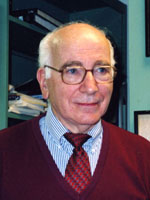
Anthony M. Trozzolo
University of Notre Dame
Organic Reactions Beget Scientific Interactions
As a graduate student at the University of Chicago in the late 1950s, I had heard glowing accounts of the Gordon Research Conferences from several of my professors. So with great anticipation I applied to attend my first Gordon Conference, called Organic Reactions and Processes, in 1960, six months after arriving at Bell Laboratories in Murray Hill, New Jersey. Although I knew this conference was very popular, I was disappointed to hear that I had been put on the waiting list. There was a GRC rule at the time that a founding sponsor of the organization had the prerogative to send one representative to each conference. Bell Labs was such a sponsor, and since no one else from there had applied, I became the organization’s representative at Organic Reactions and Processes. Immediately I became aware of the unique features of Gordon Conferences that stimulate informal discussion and encourage what we today call “networking.” These same features are what bring me back to the conferences year after year.
There I met and heard many researchers in the field I had known about only through their publications. It was a great experience for someone just out of graduate school. Among the speakers was Phil Skell of Pennsylvania State University, who spoke about the differences in reactivity between the singlet and triplet states of diphenylmethylene. Shortly after my return from the conference, Bob Murray (now at the University of Missouri in St. Louis) and I discussed at a Bell Labs blackboard how interesting it would be to make a molecule with two diazo groups and what multiplicity one might expect from the dicarbenes generated. We synthesized a number of novel diazo and bisdiazo compounds and, in collaboration with Ed Wasserman and Bill Yager, characterized the structure and multiplicity of the wide spectrum of carbenes formed by decomposition of the diazo compounds.
At the 1960 conference I met Bill Mosher, who was elected to chair the 1962 conference. I was elated to be invited by Bill to present our results on the novel carbene and dicarbene work at the 1962 conference. I am certain that this occasion played an important role in increasing the visibility of our work, and subsequent Gordon Conferences provided a vehicle for presenting further developments in these studies.
In 1962 GRC director W. George Parks published a notice in
Science soliciting proposals for new Gordon Conferences. I sent in a proposal citing the fact that no conference was being held on a continuing basis on organic photochemistry and that the subject was developing rapidly. A chance meeting at the luncheon of the 1963 Metro Regional Meeting in Newark with Cecil L. Brown, then on the GRC board of trustees, helped to reinforce the case. The Organic Photochemistry Gordon Conference was approved to be held for the first time in 1964 at the Tilton School in Tilton, New Hampshire. The meeting’s first speaker was the late Sir George Porter, who was awarded the Nobel Prize in chemistry three years later. The conference prospered, with many of the field’s developments receiving early exposure there. The conference has since become international in scope and participation.
Organizing the first meeting of a Gordon Conference series privileges the organizer to choose speakers from the entire field, since none have spoken there before. This opportunity has resulted in my lifelong friendships with speakers and conferees alike. Interestingly, my chairman’s award certificate was signed by Cecil L. Brown; ten years later I gave the Cecil L. Brown Lectures at Rutgers University.
During my tenure at Bell Labs I was occasionally asked by Bill Slichter, the Bell Labs representative on the GRC council, to attend council meetings in his absence. There
I grew to understand the personal qualities of Alex Cruickshank that made the Gordon Research Conferences so successful under his directorship. After I moved to Notre Dame in 1975, I was elected to the council and later to the Selection and Scheduling Committee, and in 1988 I became a trustee. Those assignments provided the opportunity to interact with a large segment of the chemical community. Although it is difficult to establish firmly a cause-and-effect relationship, I have no doubt that those exposures contributed in a number of ways to several milestones in my career, including becoming the Huis-king Chair at Notre Dame and serving as editor of
Chemical Reviews.
As a board member and during my fourteen-year stint on the Selection and Scheduling Committee, a number of significant changes took place at GRC. Poster sessions were added to increase conferee discussion and participation. GRC went international, with conferences meeting first in Europe, then in Asia. I also had the opportunity to meet a dedicated group of board members, who along with Alex Cruickshank, Carl Storm, Nancy Gray, and the GRC staff, have contributed so much to the history and development of the Gordon Research Conferences. The conferences now enjoy international respect and serve as a model for many other scientific meetings. However, the deepest impression left on me from these interactions is the family-like atmosphere I have had the pleasure to be a part of for the last forty-five years. Since Neil Gordon first used the special conference format that included informal discussion, the conferences have had a vital impact, not only on the careers of individuals but also on the frontiers of science of every discipline represented by GRC.